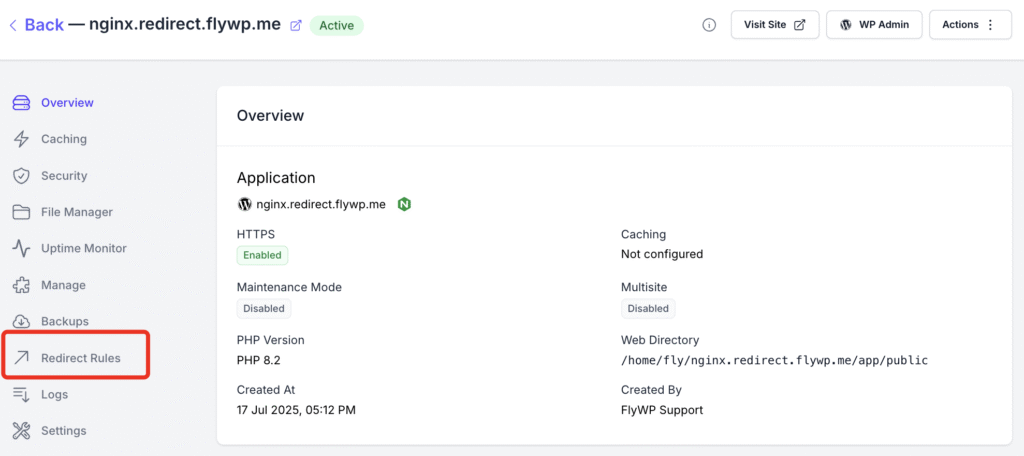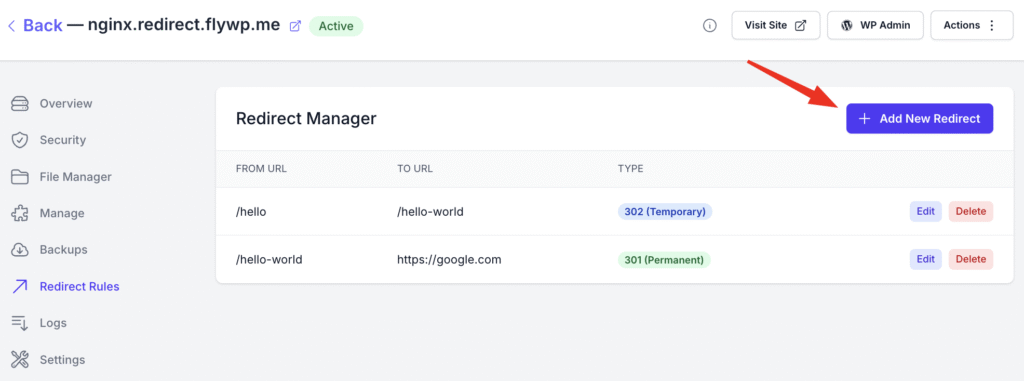Redirect Manager is a feature that lets you define server-level redirects of any sub-path, either to another path on the same domain or to a completely different domain. Redirects are processed at the web-server layer for maximum efficiency, with no PHP or WordPress overhead.

Key Features
- Define 301 (permanent) or 302 (temporary) redirects
- Redirect from a sub-path (e.g.
/old-path) to:
• another path on the same domain (e.g./new-path)
• an external domain (e.g.https://example.org/target) - Automatic trailing-slash handling – a rule for
/log-incovers both/log-inand/log-in/
Creating a Redirect Rule via the FlyWP
In the FlyWP dashboard, navigate to your site and click Redirect Rules.

- Click Add new Redirect.

- You get a pop-up for the necessary Redirect Rules information

- Fill in the form fields:
• From URL: the sub-path you’re redirecting from (leading slash required).
• To URL: the destination path or full external URL. This can either be a URL of the same domain (ie, /hello-world page) or to another domain
• Redirect Type: select 301 (Permanent) or 302 (Temporary).


- Click Create Redirect.
Your new rule is applied instantly to your web server configuration.
How Redirector Works Under the Hood
- On NGINX sites, FlyWP writes all redirect rules into:
~/site_dir/config/nginx/custom/server/flywp-redirect-rules.conf - On OpenLiteSpeed sites, rules live in:
~/site_dir/config/ols/rewrite-rules.conf - These files are managed automatically by FlyWP and are only accessible via the server file system (SSH/SFTP), not through the dashboard.
- Every time you add, edit, or delete a redirect in the UI, FlyWP regenerates the relevant config file and reloads the web server.
Testing Your Redirects
- Use a browser or
curlto verify:
curl -I https://example.com/old-path
- You should see a
HTTP/1.1 301 Moved Permanently(or302) and aLocationheader pointing to your destination.
Removing or Disabling a Redirect
- In the FlyWP dashboard, go to Redirect Rules, find the rule, and toggle it off or delete it.
- FlyWP will automatically update the server config and reload the web server.
FAQ
Q: Can I chain multiple redirects?
A: Yes. You can create multiple rules. They’re evaluated in the order defined.
Q: Is there any Regex support?
A: There is currently no Regex support on Redirect Rules.
Q: How do I handle HTTP→HTTPS redirects?
A: FlyWP by default forces HTTP to HTTPS as long as the site has a TLS/SSL certificate, so no need to set up any redirect for that.
.png)